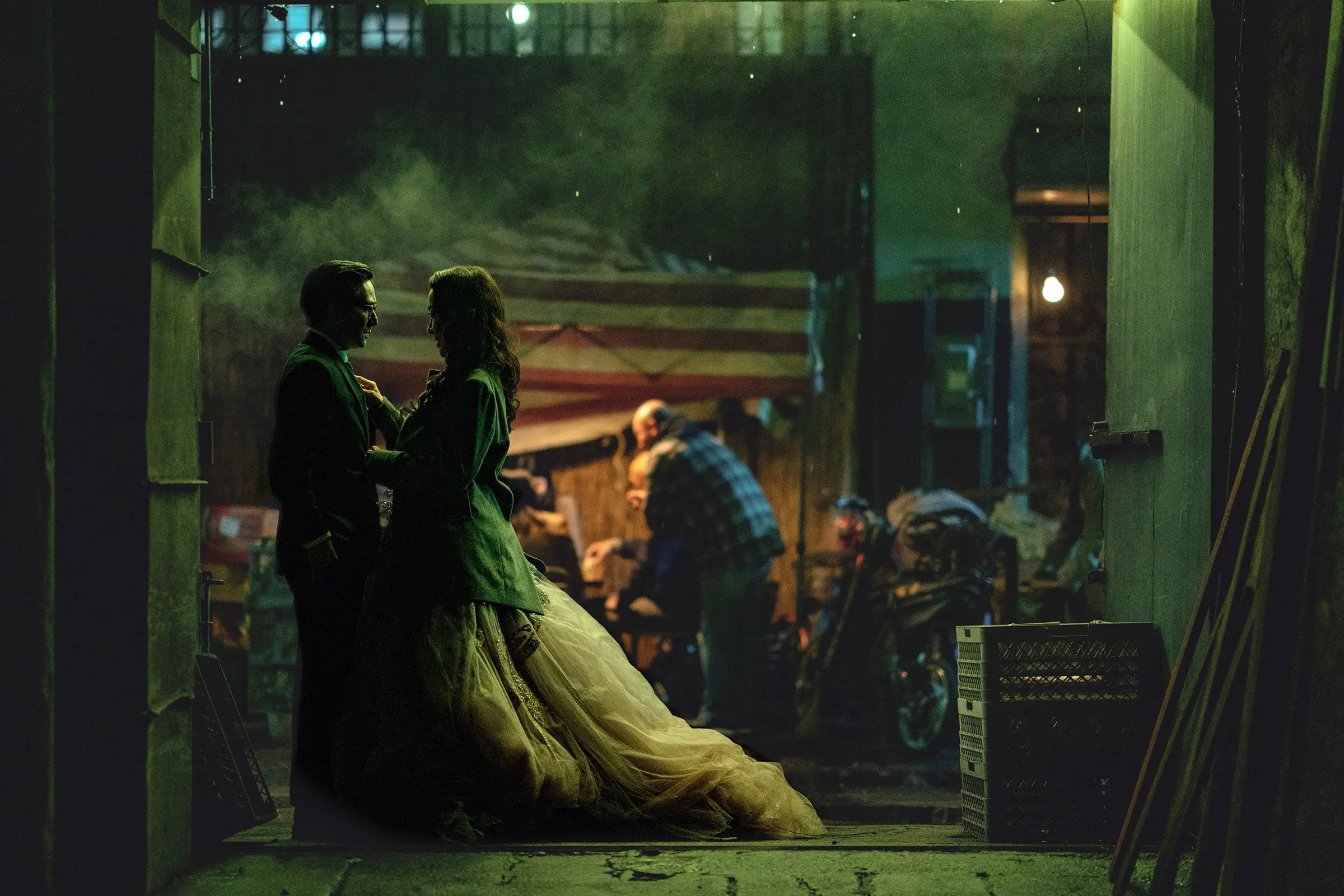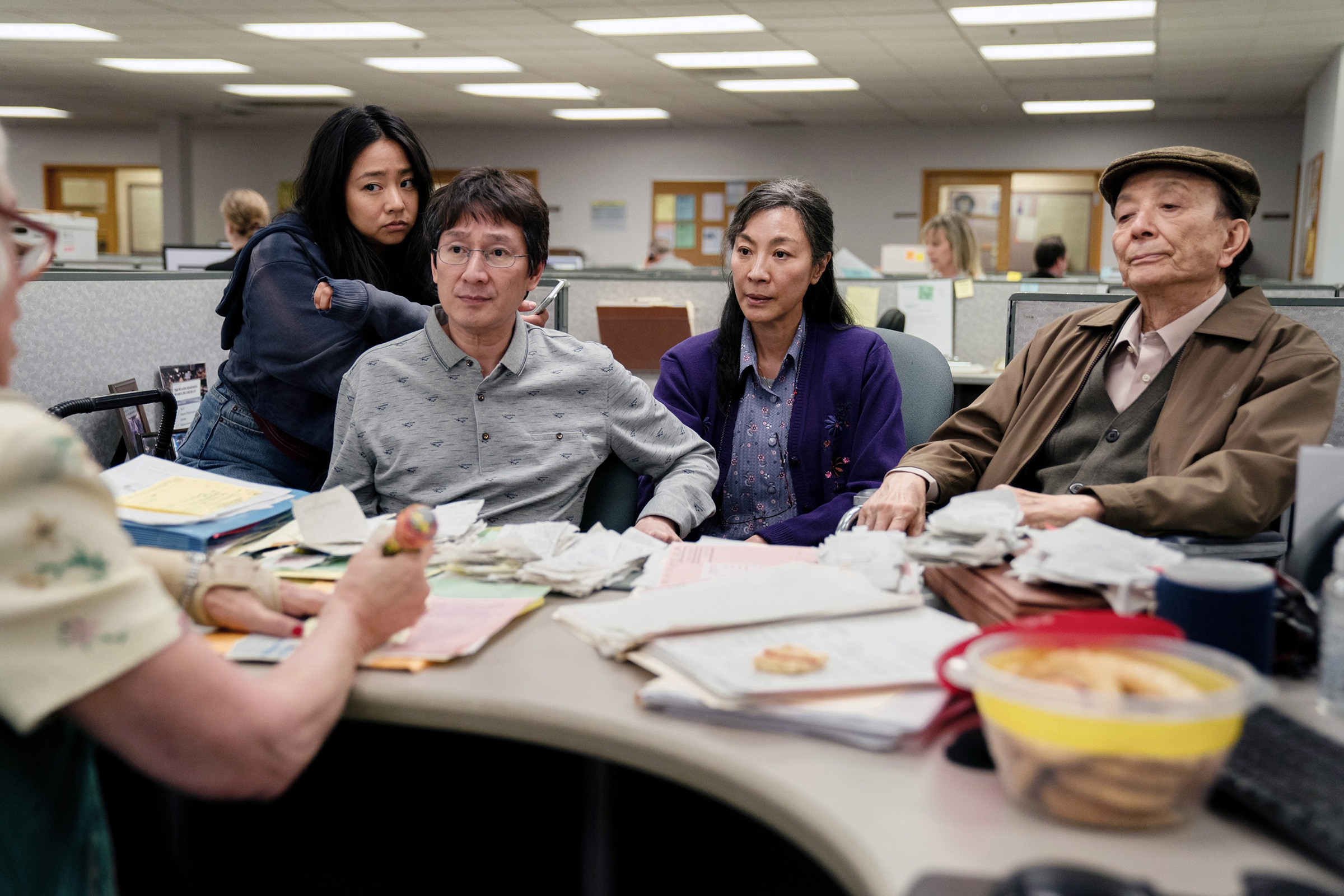It wasn’t a clean sweep, but it came close: Everything Everywhere All at Once took home seven Oscars out of the 11 for which it had been nominated. At first, no one expected it. And then, during awards season, everyone did. Then again, on Sunday night, as All Quiet on the Western Front steadily picked up wins, the mood grew uncertain. But Everything Everywhere pulled through.
“My journey started on a boat,” Ke Huy Quan said in his acceptance speech after winning Best Supporting Actor. “I spent a year in a refugee camp. And somehow, I ended up here, on Hollywood’s biggest stage. They say stories like this only happen in the movies. I cannot believe it’s happening to me. This, this is the American dream!”
Alongside Quan, Jamie Lee Curtis won Best Supporting Actress (which meant Stephanie Hsu lost, although she performed “This Is a Life” from the movie beautifully), Michelle Yeoh won Best Actress (making history), Paul Rogers won Best Editing, Daniel Kwan and Daniel Scheinert (collectively known as the Daniels) won Best Original Screenplay and Best Directors—plus the film snagged the crown jewel, Best Picture. Quan and Yeoh’s combined wins marked the first time two Asian actors won in a single year.
“For all the little boys and girls who look like me watching tonight, this is a beacon of hope and possibilities,” Yeoh said in her acceptance speech. “This is proof—dream big—and dreams do come true. And ladies, don’t let anybody tell you you are ever past your prime. Never give up.”
A year ago, on the eve of Oscars weekend, Everything Everywhere All at Once was released on 10 screens across the U.S., grossing over half a million dollars in its opening weekend. From there, it expanded and has since earned more than $100 million worldwide, becoming the independent production company A24’s first film to do so.
Its box office success was matched by critical acclaim, racking up enough accolades to have their own Wikipedia page. In January, Everything Everywhere garnered 11 Oscar nominations—the most of any movie this year.
But nobody expected for the film to make it this far—perhaps least of all the Daniels, says Jeff Yang, co-author of Rise: A Pop History of Asian America From the Nineties to Now. This was an indie spring release, while most Oscars heavy hitters, by major movie studios, premiere at prestigious fall film festivals. Other Best Picture nominees, like All Quiet on the Western Front and The Fabelmans, for instance, opened at the Toronto film festival, while The Banshees of Inisherin and Tár premiered in Venice. Elvis and Triangle of Sadness debuted at Cannes, and Women Talking at Telluride.
“There were so many good stories about the film, but they’re all the kind of stories that point to indie success and critical darling,” Yang tells TIME. “They don’t point to awards blockbuster. They definitely don’t point to a clean sweep—every major mark of inevitability that is possible coming up Everything Everywhere All at Once.”

Feel-good stories swirled around the movie, including, but not limited to, Ke Huy Quan’s return to acting after nearly two decades away. Then, between mid-February and early March, came a string of recognition from Hollywood: the Directors Guild of America (DGA) gave Daniels a trophy for feature directing. The Producers Guild (PGA) bestowed the film its top honor. The Screen Actors Guild (SAG) showered it with awards. The Writers Guild (WGA) named Everything Everywhere Best Original Screenplay. Not to mention the Golden Globes that Yeoh and Quan picked up in January. The movie soon became a veritable frontrunner for Best Picture.
But, as Yang qualifies, “I have to sometimes be reminded that all of the accolades coming from these guilds—and even the Academy Awards—if we actually put them into context, the only reason why they are so meaningful is because we haven’t had them in the past. But they really are this weird sense of us clutching at the hem of the Hollywood establishment.”
Read More: Where to Watch or Stream All the 2023 Oscar Nominees
In early March, the Annenberg Inclusion Initiative launched the Oscars report companion to its forthcoming Inclusion List. The report revealed that 20 nominations, or 9% of all Asian nominees, were named in 2023—the highest number and percentage yet. More than half of those nominees were associated with Everything Everywhere All at Once.
“We can herald Everything Everywhere All At Once, but the concern is: How is it a token illustration, rather than looking at a governing body that’s really committed to inclusion over time?” says Stacy L. Smith, the founder of the Annenberg Inclusion Initiative. “We have 35 years where no Asians have been nominated, in the 95-year history. 35 years.”
How the movie got here
Yang first saw the film at a press screening in late February of last year, a month before it came out. He didn’t expect it to change the world. Rather, he and many others felt connected to it intimately and individually—the polar opposite of watching a Marvel movie in a packed theater.

“That’s why it’s such a gratifying shock to see that all of us—all of us who were having this one-on-one personal relationship with hotdogs-hands Jesus—are now forming this mighty army that might actually be getting this thing the Academy Awards’ recognition and mainstream artistic and commercial success,” Yang says, “that in so many ways has eluded this particular type of defiantly independent Asian American film for so many decades.”
Everything Everywhere is definitely Asian: it pays homage to Wong Kar-wai’s In the Mood For Love, Hong Kong filmmaker Stephen Chow, kung-fu, and martial arts—upon which Michelle Yeoh built her career. In fact, Yeoh’s lead character was originally conceived for Jackie Chan.
And it is simultaneously a deeply American film—and a deeply Daniels one. Its technicolor multiverse concept originated in 2010, when Daniel Scheinert was watching Sherman’s March. The documentary’s main character meets a linguist who tells him about modal realism, the idea that all possible worlds are real in the same way as the actual world.
Sign up for More to the Story, TIME’s weekly entertainment newsletter, to get the context you need for the pop culture you love
“That’s really appealing to us because we’re maximalist filmmakers,” Kwan told Vulture. “The multiverse became a vessel for us to point at infinity in a way that most other premises probably wouldn’t allow for.”
“Maximalist filmmakers” is, perhaps, an understatement: Before Everything Everywhere, Daniels were best known for the surreal black comedy Swiss Army Man, starring Daniel Radcliffe and Paul Dano. In it, a marooned man (Dano) teaches a flatulent corpse (Radcliffe) about the ways of the world. And before that, the duo directed whiz-bang music videos, including DJ Snake and Lil Jon’s “Turn Down For What.”
The everything bagel: cultures, languages, generations
A maximalist movie peppered with sight gags ranging from hot dog fingers to butt plugs is, on the surface, an unlikely candidate for Best Picture. But then there is, of course, the everything bagel. Jobu Tupaki (Stephanie Hsu), the film’s quasi-villain, has created a singularity: a bagel topped with literally everything in the universe.

The bagel is, in many ways, a microcosm for the film. Most of its main cast is Asian, yes, but the actors’ backgrounds are diverse: Yeoh is Malaysian, Quan is Vietnamese, Hsu is Chinese American, and James Hong grew up partially in Hong Kong. And Everything Everywhere is a rare trilingual film, rotating between English, Mandarin, and Cantonese. Zhen Zhang, the director of the Asian Film and Media Initiative at NYU, considers it both sinophone cinema and very much an American film.
“This is what I mean by a new multiculturalism: more culturally, linguistically informed, more complex and layered, rather than, say, 20 years ago, the ‘salad bowl’: just mixing different colors together,” Zhang says. “It’s not about colors; it’s not about black or white or yellow. There are many shades of all of these colors. Asians, everywhere in the world—I guess ‘everything’ refers to that in some ways, too.”
The movie bends genres just as it does the space-time continuum. It’s also a melodrama—a central research area of Zhang’s—which unlocks pathos and emotion. And it bridges generations, both in its plot and its reception. Its feeling of gamification was a lot for Zhang to take in, even as a film scholar.
But her son’s generation is “so used to moving instantaneously between different dimensions and building worlds,” she says. “And in that way, the film has this interactive aesthetic, as well. So you need to be engaged in it, instead of just relaxing and chewing over your popcorn.”
Everything Everywhere All at Once is, at its core, a movie by and for everyone: young and old, Chinese-speaking and not, Asian and American and Asian American, laundromat goers and movie stars. It is intrinsically universal in its specificity.
More Must-Reads from TIME
- How Donald Trump Won
- The Best Inventions of 2024
- Why Sleep Is the Key to Living Longer
- Robert Zemeckis Just Wants to Move You
- How to Break 8 Toxic Communication Habits
- Nicola Coughlan Bet on Herself—And Won
- Why Vinegar Is So Good for You
- Meet TIME's Newest Class of Next Generation Leaders
Contact us at letters@time.com